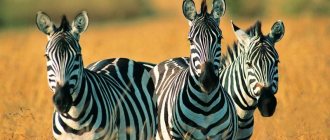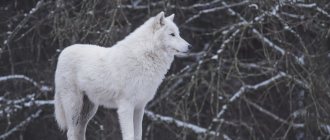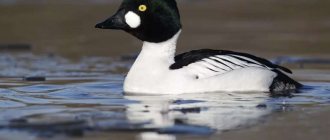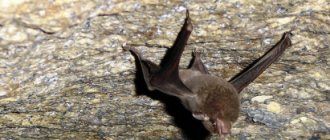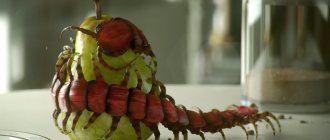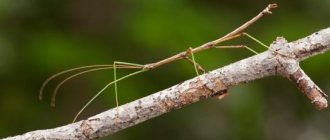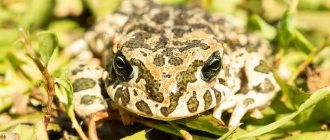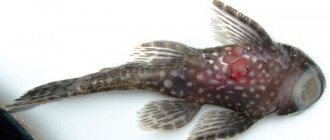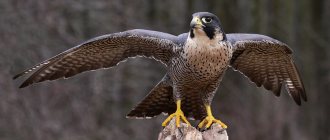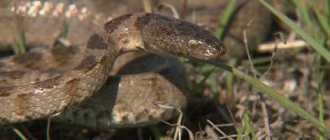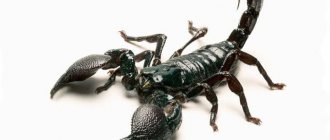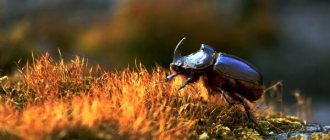- Wild animals
- >>
- Mammals
The pig-footed bandicoot is the smallest and most graceful marsupial mammal belonging to its own genus. These long-eared, long-tailed herbivores once scurried across the sandy, arid reaches of central and western Australia for tens of thousands of years before going extinct in the 1950s. You can learn more about the life and reasons for the extinction of the smallest marsupial mammal on the Australian continent from this publication.
Origin of the species and description
Photo: Pig-footed bandicoot
This genus was previously classified in the family Bandicoots (Peramelidae) along with the Rabbit bandicoots (Macrotis). However, its shape is quite different from bandicoots, and recent molecular evidence supports this difference. It is currently believed to be a parallel sister group to the rest of the bandicoots (Peramelmorphia). As a result of these molecular studies, the animal was assigned to its own family, Chaeropodidae.
The species was first described in the 19th century from specimens found in the north-western regions of Victoria and the arid zones of South Australia. The last specimen was caught in 1907 near Lake Eyre. The species is believed to have survived in the wild until the 1930s and 1950s, struggling to survive in remote parts of Western and Southern Australia.
Video: Bandicoot
Until 2022, the two current species were grouped into one, C. ecaudatus. However, a new study of specimens from the Museum of London and the Australian Museum analyzed all 29 existing specimens, taking careful bone measurements and comparing DNA samples collected in the 1940s.
Scientists have identified two types:
- northern pig-footed bandicoot;
- southern pig-footed bandicoot.
The newly described species, named Chaeropus yirratji after the local Aboriginal name for the creature, has larger hind legs and a longer tail than its better-studied cousin (C. ecaudatus) and may have had different behavior. Future understanding of the differences between the two species depends on whether researchers can find more fossils, which tend to be found in caves covered in owl droppings.
What does a giraffe look like?
The height of giraffes reaches up to 5.7 m, of which 3.3 m is from the body to the shoulders, 2.4 m is from the neck to the horns. Males are larger than females, which are smaller on average by 1 m. Males weigh 1500-1900 kg, females - up to 1200. A newborn cub weighs 50-55 kg, height is 2 m. Life expectancy - 25 years in a zoo, 10-15 years in the wild.
They have thick skin covered with a coat of short hairs. Lengthening of the fur is noticeable only on the mane, back, forehead and tail brush. The main color is little noticeable, most of the body is covered with spots. The coloring of the coat is different for each species, depending on the area. The spots vary in size, color, location on the body, and number. Shades of spots range from yellow to black. The coat pattern obtained during intrauterine development remains unchanged throughout life. Small spots on the long neck and legs, absent on the ventral abdomen and inner legs.
The giraffe's legs are thin but strong, the front ones are longer than the back ones. The long neck also consists of 7 cervical vertebrae, the size of which is longer than usual. The back is sloping, ending in a thin long tail 100 cm. The tip of the tail in the shape of a brush is a necessary device for protection against insects. On the head there are 2 horns of 15 cm each with tassels at the end. They are formed from bone tissue covered with skin and hair; in females they are thinner than in males. Another bony growth is located in the middle of the forehead, which is not a horn.
The tongue of giraffes is black, large and long, which helps with feeding, and the muzzle is long and elongated. Reaches a length of up to 45 cm - this is necessary for obtaining food. The giraffe feeds on leaves from trees, which it grabs from the upper branches using its tongue.
Appearance and features
Photo: Pig-footed bandicoots
Pig-footed bandicoots had a length of 23–26 cm, and a long tail reached 10–15 cm. They had long thin limbs and large pointed ears. A closer look reveals that the pig-footed bandicoot is a very unusual species for marsupials. The animal's front legs had two functional toes with hooves, quite similar to the hooves of a pig or deer. The hind feet had an enlarged fourth toe with a heavy claw in the shape of a tiny horse's hoof, which was used for locomotion.
Interesting fact: The maximum body weight of the pig-footed bandicoot reached 600 grams (the weight of a basketball) and a length of 26 cm, which makes these mammals one of the smallest grazing animals that have ever lived on Earth.
The remaining fingers were vestigial: only the fused second and third fingers were useful, not for movement, but for grooming. They had wide heads and a long but elongated muzzle. The fur was straight, stiff and rough, but not prickly. Colors ranged from gray to fawn-orange and even orange-brown, the belly and underparts were white, and the fur on the ears was chestnut in color. Its orange-brown elongated tail ended in a black tuft.
The pig-footed bandicoot had about 46-48 teeth inside its long jaws. The incisors were flattened and the cheek teeth were selenodont. The animal had three pairs of lower and five pairs of upper incisors. The shape of the teeth in the two species differed from each other. Females had eight teats, and the opening of the sac faced backwards rather than forwards, as is the case with kangaroos.
Now you know what the pig-footed bandicoot looked like. Let's see where this unusual animal lived.
general information
Dugongs are closely related to manatees and are commonly known as “sea cows” due to their peaceful grazing lifestyle. They have dull gray, torpedo-shaped bodies with flipper-like front legs and a small tail, similar in appearance to a dolphin's. The dugong lacks dorsal fins and hind limbs. Mature males have tusks.
Sea cows are very shy and do not like to be approached by researchers, making it difficult to study and obtain data on these elusive animals.
The dugong's closest relative, Steller's cow (or cabbage), was exterminated by humans within 27 years of its discovery in the 18th century.
Size
Adult dugongs can reach from 2.5 to 4 meters in length and weigh around 600 kilograms. By the way, the babies have no less impressive sizes - 1.2 meters in length and weight up to 30 kg.
Where does the dugong live?
Dugongs are found in coastal waters from the western Pacific Ocean to the eastern coast of Africa. They are strictly marine mammals, unlike manatees, which require fresh water.
They are highly dependent on their habitat, mainly due to the aquatic plants of the pondweed and aquatic family that make up their diet. Therefore, their habitat is coastal areas, bays and lagoons.
origin of name
The name "sea cows" comes from the fact that these animals love to feast on marine vegetation in shallow waters. Dugongs have very sensitive snouts that end in forked lips with vibrissa bristles.
What does the dugong eat?
This anatomy allows this relative of the manatee to easily pick off algae like a vacuum cleaner. If kelp beds are sparse at lunchtime, dugongs may feast on invertebrates such as jellyfish or small shellfish. Feeding usually occurs at a depth of 1 to 5 meters.
Lifestyle and reproduction
Dugongs become mature between 8 and 11 years of age. As males mature, their tusks will become visible and will further assist in the process of fighting to impregnate a female. Males do not participate in raising offspring.
In turn, females produce offspring throughout their lives. There is almost always one cub in one litter. It is very rare for a female to give birth to two at once. The gestation period lasts about a year. After birth, the mother feeds the baby with milk for 12–18 months, after which it begins to learn to eat algae on its own. As they grow up, babies like to gather in schools in shallow water, and in order to dive into the deeper layers of the ocean, they cling to the backs of their mothers.
Female dugong with baby
Because the seagrass beds cannot support large groups, dugongs are often solitary or live in pairs. And the main danger for them are large sharks, saltwater crocodiles and killer whales.
Threat of extinction
Although commercial hunting of dugongs has been banned, they are still listed as an endangered species on the Red List due to habitat loss from coastal development, as well as water pollution caused by industrial activities.
Animals can also become victims of fishing by becoming entangled in fishing nets.
Good sitrass habitat is vital for dugong reproduction. They have few natural predators, but in addition, young individuals are very susceptible to disease. In the end, I would like to supplement the story about these animals with some interesting facts:
In the end, I would like to supplement the story about these animals with some interesting facts:
- Life expectancy is more than 70 years.
- More closely related to elephants than to other marine mammals.
- Skin color may change due to the algae it consumes.
- The dugong sometimes “stands” on its tail, sticking its head out of the water.
- As soon as a small dugong is born, the mother pushes it to the surface so that it can breathe air.
- It is believed that sea cows inspired ancient storytellers to create images of mermaids and sirens.
- Dugongs and manatees are the only herbivorous marine mammals alive today.
- They love warm water.
- There may be more than 80,000 in Australian waters, representing more than half the world's total.
- The scientific name of the dugong is Dugong dugon.
Where does the pig-footed bandicoot live?
Photo: Animal pig-footed bandicoot
The pig-footed bandicoot was found in central and southern Australia around the west coast at Carnarvon and the wheat belt of south-western Australia to western New South Wales and north-western Victoria. These animals lived in different habitats. In the central deserts it occupied sand dunes and sand plains. In Victoria he lived on the grassy plains. Elsewhere, the pig-footed bandicoot showed a preference for open forests containing shrubs and grass.
During the day it took refuge in a grass-lined nest or, in deserts, in a short, straight burrow with a nest at the end. In the central deserts, it inhabited sand dunes and shallows with hummocky grass Triodia, sometimes with an aboveground layer of acacias (A. aneura). In north-west Victoria this occurred on grassy plains, while in other places the animal was favored by open forests with bushes and grass.
Despite the wide range of settlement, the genus had a scattered distribution and was never numerous. The range of the genus at the end of its existence was reduced to the interior desert region, where it was last recorded in the 1950s. Although no documentary evidence of this has been found. It is now assumed to be extinct.
[edit] Literature
- Biological encyclopedic dictionary. Chief editor M. S. Gilyarov; Editorial team: A. A. Babaev, G. G. Vinberg, G. A. Zavarzin and others—2nd ed., corrected. - M.: Sov. Encyclopedia, 1986.
- Sokolov V. E. Systematics of mammals. Volume 1 (Orders: monotremes, marsupials, insectivores, woolly wings, bats, primates, edentates, lizards). — M.: Higher School, 1973.—P.72—77.—432 p.
- Complete illustrated encyclopedia. "Mammals" Book. 2/The New Encyclopedia of Mammals / ed. D. MacDonald.—M.: “Omega,” 2007.—P.392—395, 435.—3000 copies. ISBN 978-5-465-01346-8
- Great Soviet Encyclopedia. - M.: Soviet Encyclopedia. 1969-1978.
- Animal life: in 6 volumes. — M.: Enlightenment. Edited by professors N.A. Gladkov, A.V. Mikheev. 1970.
What does the pig-footed bandicoot eat?
Photo: Animal pig-footed bandicoot
There are many conflicting reports about the diet of pig-footed bandicoots. The structure of their teeth and intestines suggests a more herbivorous diet than that of most bandicoots. However, the aborigines report that these animals ate termites and ants and may even have had a taste for meat.
However, the diet in captivity consisted of:
- herbs;
- lettuce leaves;
- rhizomes;
- bulbous roots;
- grasshoppers;
- other insects and possibly small vertebrates.
This confirms the more herbivorous rather than omnivorous diet of pig-footed bandicoots, even a certain degree of animal grazing. These bandicoots used their sense of smell to find food on the ground or in holes they dug.
From surviving eyewitness accounts and analysis of the intestinal contents, dentition, and intestinal structure of museum specimens, it is clear that pig-footed bandicoots were the most herbivorous of the bandicoot family. In captivity, it was observed that animals drank a lot of water.
Fun fact: Kenny Travillon at the Western Australian Museum in Perth examined three fossilized teeth that had languished in the museum's collection since they were dug up in New Wales in the 1970s. He discovered that C. ecaudatus descended from an earlier omnivorous species, C. baynesi, which predates Australia by two million years.
Based on the research, Travouillon concluded that the rapid drying of the climate could trigger the transition to a herbivorous diet from a carnivorous-herbivorous diet, but two million years is an unusually short time. Diet evolution usually takes longer. The scientist insisted on his version, taking into account the fact that small mammals usually do not graze because their stomachs are not large enough to digest the grass for a long time and extract some nutrients from it.
Diet of the marsupial badger
Bandicoots are omnivores. Small, but sharp and strong, like a cat’s fangs, allow the animals to cope with lizards and small rodents. In the absence of such attractive prey, marsupial badgers do not neglect snails, termites, worms, centipedes, and insect larvae. They are not averse to eating juicy fruits, bird eggs, roots and seeds of plants.
The need for water in bandicoots is minimal, since they receive the moisture necessary for vital processes along with food.
Return to content
Features of character and lifestyle
Photo: Pig-footed bandicoot
Pig-footed bandicoots were solitary animals that were not fully nocturnal, like other bandicoots. Depending on the environment in which the animal lived, it built nests covered with grass, or dug short holes with a nest at the end. The pig-footed bandicoot's most noticeable behavior was its movement. Most often, the animal slept in its shelter during the day and came out in the evening to feed, using its keen sense of smell to find food.
Interesting fact: There is an interesting story behind the name Chaeropus ecaudatus. Hog-footed bandicoots get their name from the discovery of a specimen that had lost its tail in an accident. The author of the description of this animal suggested that it was tailless, although in fact C. ecaudatus had the longest tail of all bandicoots. The mistake was not recognized until it was too late to rename the animal. Now, the Latin name will forever remain, Chaeropus ecaudatus, i.e. "tailless pig's foot."
When moving, the animal's movements were extremely varied, depending on what kind of gait it required. The slow gait was similar to that of a rabbit and the hind limbs were brought together. The intermediate gait was a clumsy quadrupedal race with a transverse movement of the hind limbs. In contrast, Aboriginal people reported that pig-footed bandicoots could reach great speeds when pursued using a smooth, loping gait.
[edit] Links
| Mammals (Mammalia ) and their taxonomy | |
| Prime beasts ( Prototheria ) |
)
| Placentals ( Eutheria ) | Afrosoricida ( Afrosoricida ) • Armadillos ( Cingulata ) • Rodents ( Rodentia ) • Hyraxes ( Hyracoidea ) • Urchiniformes ( Erinaceomorpha Lagomorpha ( Lagomorpha ) • Shrews ( Soricomorpha ) • Cetaceans ( Cetacea ) • Odd-toed ungulates ( Perissodactyla ) • Incomplete edentates ( Pilosa ) • Pangolins ( Pholidota ) • Artiodactyla ( Artiodactyla ) • Primates ( Primates ) • Jumpers ( Macroscelididae ) • Chiroptera ( Chiroptera ) • Sirens ( Sirenia ) • Aardvarks ( Tubulidentata ) • Tupaia ( Scandentia ) • Carnivores (Carnivora ) Proboscidea • Woolwings ( Dermoptera ) |
Social structure and reproduction
Photo: Pair of pig-footed bandicoots
Not much is known about the specific reproductive patterns of pig-footed bandicoots, but a general picture can be created based on the reproduction of other bandicoots. Females of the genus had 8 nipples. The females also had a well-developed pouch that opened at the back. Tim Flannery suggests that breeding occurred between May and June, and that twins may have been the norm for the species. From the size of its pouch and comparison with other marsupials of its size, it can be concluded that lead bandicoots did not produce more than four young per litter.
Hog-footed bandicoots typically have a very short gestation period, about 12 days from conception to maturity. The birth is also very short, probably lasting less than 10 minutes, with the young weighing only about 0.5 grams. Most likely, another mating occurred 50 days after birth, shortly after the weaning of the first brood. This means that the animals could produce up to 16 cubs per season.
A new litter was born after about 10 days. In pig-footed bandicoots, each suckler had its own nipple and received the same amount of milk. Females could produce offspring from the age of three months. The newborn was in the mother's pouch for 55 days. By the end of the period of being in the mother's pouch, the young bandicoot chicks remained in the nest for some more time, 1-2 weeks, and after that they began an independent life.
Secrets
Unexpected surprise
Main article: Crash Bandicoot (game) Cheats
Cortex in the intro.
Before Crash falls out of the window, you can see Cortex flying up to the castle on his glider. What he forgot there remains a mystery.
More than 99 lives. It is possible to have more than 99 lives using a bug. To do this, you need to accumulate 99 lives, get the hundredth, and at the moment when a new life “flies” to the counter, you need to exit the level. Then we go to any level and rejoice at the beautiful number 100 in lives
Important: if you get another life, the counter will return to 99.
Spin TNT explosion.
You can blow up TNT and still be alive without a mask if you jump on it, and then jump on it and start spinning at the same time. Then TNT will explode under Crash, and he will remain intact.
Boss vulnerabilities.
Almost all bosses have their own glitches or secrets that make defeating them easier. In order:
Papu Papu.
He has two vulnerabilities: 1) You can stand on his throne and miss spin attacks, but only if you stand on the armrest; 2) It can also be attacked while it is spinning
Ripper Roo.
As a last resort, you can manually detonate TNT by sacrificing the mask, but this will be of little use. By the way, large TNTs cannot be blown up by spinning on them.
Koala Kong.
Its stones can be broken by spinning, and the last, heavy stone can be knocked away without waiting for it to land.
Pinstripe.
It can be attacked three times in a row when it first recharges while moving.
Nitrus Brio.
It doesn’t help you win, quite the contrary, but there is a glitch. When he has one life left and you have a mask, you can stand on a brick and just wait for him to reach the brick. When he gets there, he pushes away as if he had been attacked, and Brio's life bar disappears. Now the boss starts to accelerate, and if you are not on the brick, Crash will be attacked. By jumping on bricks, you can achieve Brio's really crazy speed, to the point where it will be very difficult to hit him. This madness stops with a simple jump on Brio's head.
Cortex.
The last boss, surprisingly, was not noticed with any glitches.
Secret items.
Some levels have especially cleverly hidden items that can only be found randomly. A list of them and a gallery of their locations is below.
Hidden life.
At The Great Gate level, there is a life above the structure of a box with an arrow, a box with wamps and an iron box; to get it, you need to jump on the jumping iron box.
Secret passage.
In the Native Fortress level, there is a secret passage through the fence that allows you to bypass most of the troubles without missing the boxes.
Hidden life.
On the same level further down there is a similar recess that contains one life.
Hidden mask.
In The Lost City level, there is a mask hidden above two platforms going in a circle; you need to jump at the highest point.
Life near Crash.
Secret passage - entrance.
Secret passage - exit.
Next up is life.
The mask is near Crush.
Add photo to gallery
Natural enemies of pig-footed bandicoots
Photo: Extinct Hog-footed Bandicoot
It is difficult to establish exactly what caused the extinction of this species and which predators hunted them most intensively. The pig-footed bandicoot had little economic value to humans. However, the Australian Aborigines did enjoy its meat as a delicacy and used its tail tuft to create jewelry.
Interesting fact: In 1857, local residents gave two specimens of the pig-footed bandicoot to D. Krefft, who accompanied Blandovsky's expedition. Despite the difficulties in obtaining live specimens, Krefft recorded his observations of the animal with an apology for having eaten one of them.
A small number of specimens of the animal were collected in the second half of the 19th century, mainly from north-western Victoria, but also from the arid zone of southern, western and northern Australia.
Depending on the area, pig-footed bandicoots used different shelters to hide from predators. In forested areas and meadows, they settled in hollow logs and nests made of grass, and in arid, treeless areas, this animal usually dug straight, short burrows with a nest at the end.
The onset of livestock farming and overgrazing by sheep and cattle in favorable habitats for the species have also altered the composition of plants important to the bandicoot. Although Europeans eventually introduced rabbits, foxes and cats to compete with the pig-footed bandicoot, this was not the immediate cause of their extinction. The decline in the animal's population began before the appearance of this new fauna.
Interesting Facts
- The name Coco is derived either from the word chocolate (chocolate), or from coconut (coconut; coco), or from cocoa (cocoa).
- In TTR
, Coco says her IQ is 164. - Some perverts believe that
Cortex left her without clothes of Twinsanity The fact that Coco later appears in the same clothes (although, on the other hand, the house with the wardrobe was very close...) proves the opposite. - Not only is she a hacker and somewhat of a troll (hacked Cortex's computer in CB2
just for lulz), but she also speaks leet in
TTR
. - One of the characters that appears in all racing games in the series (like Crash, Cortex and N. Gin).
- Almost the only character who changes over time precisely because of age ( CB2
-
Twinsanity
- looks like a little girl, with ages from 9 to 12, but in Titans... you know it yourself). - Each Coco model in Naughty Dog games is called Naughty Coco.
- She has her own racing track, known as Coco Park (Coco Park in CTR
). - Crush and Coco's parents were killed by a fox (as recalled by Ratcycle in MoM
). - On the artwork Crash Bash
, which hangs in the gallery, she is holding TNT, but the timer is not running - Coco was ranked 24th out of 25 on the list of the sexiest characters in games according to Playstation Official Magazine.
- According to Charles Zembillas, the character Coco was created as a replacement for Tawna. The reason for this was ND's extreme "sensitivity" towards Sony Japan, which meant they constantly had to please them. Sony Japan didn't feel comfortable with sexy characters like Tawna, so ND, instead of trying to convince their Japanese comrades, introduced Crush's little sister into the story.
Story
Сoco's theme
Soundtrack by Coco from Crash Bandicoot 2: Cortex Strikes Back
Crash Bandicoot 3: Warped
In this part, Coco is a playable character. Aku Aku reports that Coco and Crush need to use the time machine to collect all the energy crystals before Cortex does. Coco helps her brother obtain them, traveling to 17th-century China, the 18th-century Pacific, and World War I Europe. Crush’s sister also manages to defeat Doctor N. Jin, with whom her new pet named Pura helps her in the fight on the Moon.
Crash Team Racing
Coco is a playable character driving a pink kart that can accelerate quickly. Her home track is called Coco Park. In the epilogue of the game it is reported that she opens her own online dating site.
Crash Bash
Koko is a member of Team Aku Aku. In Crate Crush, she can throw boxes by spinning them over long distances, but she doesn't throw them very far. In Polar Push, he can push the enemy twice in a row, and has a large supply of energy. In Tank Wars, it shoots fireballs moving at medium speed. Coco's best skills are shown in the Pogo mini-games, where she, just like Crash, is able to move the fastest on pogo sticks.
Crash Bandicoot: The Wrath of Cortex
Coco activates a new room with portals in order to collect all the crystals and thereby stop the Elementals wreaking havoc on Earth. Towards the end, he helps Crush and Crunch escape from Cortex's malfunctioning space station.
Crash Bandicoot 2: N-Tranced
N. Trance kidnaps Coco, Crunch and Fake Crush, after which he puts them into a state of hypnosis. A hypnotized Coco fights Crush on a huge ship inside an active volcano. After Coco escapes N. Trance's control, she becomes available as a playable character and receives two crystals, escaping the wrath of a fireball created by N. Tropy.
Crash Nitro Kart
Coco, Crash and Crunch participate in Emperor Velo's galactic tournament. Only after winning the race will they be able to return back to Earth. In one cutscene, Coco uses her hacking skills to put a hyperactive Nash to sleep.
Crash Bandicoot Purple: Ripto's Rampage
Coco will team up with the Professor to track down Dr. Cortex and Ripto. A little later, they are both kidnapped and locked in a cage by Cortex's niece Nina. After they are freed, Coco explains to Crush and Spyro that it is necessary to plant a special device on Cortex and Ripto that can track them and lead them to their enemies' lair. The last major contribution of Sister Bandicoot in this part is the construction of a portal to that very lair.
Crash Twinsanity
Doctor Neo Cortex stuns Coco in order to disguise himself as her and lure Crush into a trap. Some time later, Coco comes to her senses and, believing that the doctor has kidnapped Crush, goes to the iceberg laboratory to save her brother. Upon arrival, she attacks Cortex, but he manages to defend himself, as a result of which Coco remains paralyzed throughout the remaining events of Twinsanity
In the early version of the game, Coco played a more important role, helping Crush and Cortex gain access to the airship by hacking the security system of Cortex's old castle in levels parodying the Matrix film series. Additionally, a stage called "Gone a Bit Coco", where Cortex went into Coco's brain due to the Psychotron malfunctioning, was removed.
Crash Tag Team Racing
Coco was the only character to find a clue leading to Willie Wampa Cheeks, the thief of MotorWorld's Power Gems. At the end of the game, it is proposed to give the park to Crush, Coco and Crunch, but Bandicoot's sister returns it to Vaughn Clutch, realizing that this place is home to him.
Crash Boom Bang!
Coco plays a central role when millionaire Viscount invites her to take part in the World Cannonball Race and find the Super Big Energy Crystal.
Crash of the Titans
At the beginning of the game, when Coco was developing a device necessary for processing oil, Cortex flies up to the bandicoots' house in his airship, who, after a short dialogue, kidnaps Coco and sends her to his castle. At the moment when Nina replaces her uncle Cortex, she brainwashes Crash's sister, after which she forces her to modify the Duminator. In the finale, Bandicoot successfully defeats the Duminator and saves Coco.
Meaning for a person.
Long-nosed bandicoots constantly dig up the soil in search of suitable food, so they create a problem in homesteads, gardens and lawns, damaging the root system of plants and leaving behind dug holes. These actions have given them a reputation as crop pests. However, these animals bring more benefit by searching for larvae, and cause little damage to the roots.
